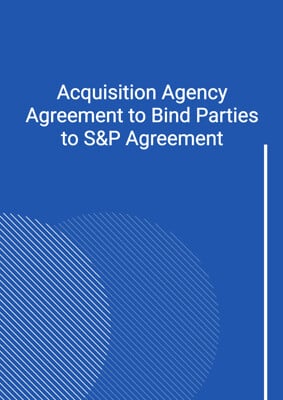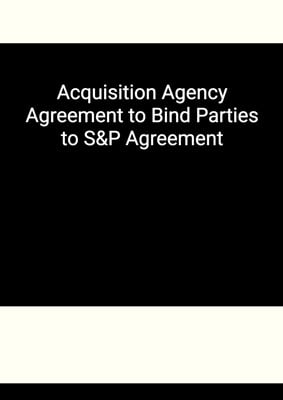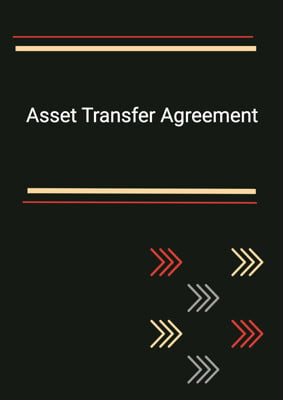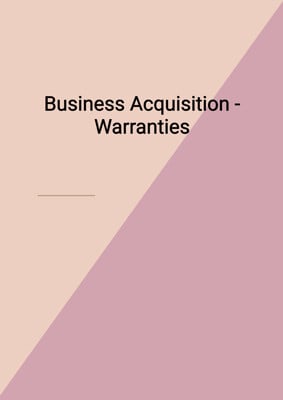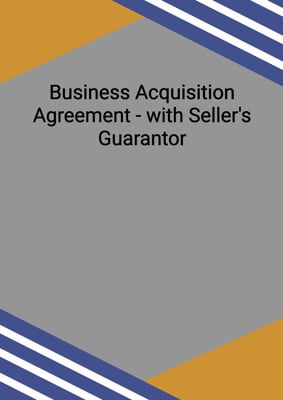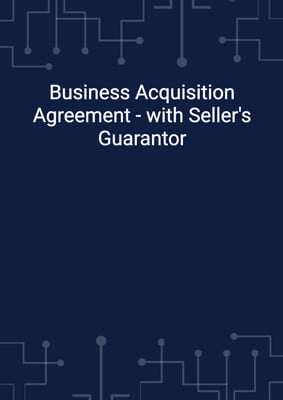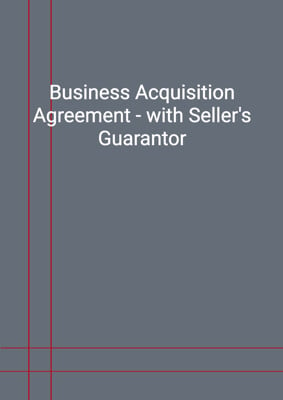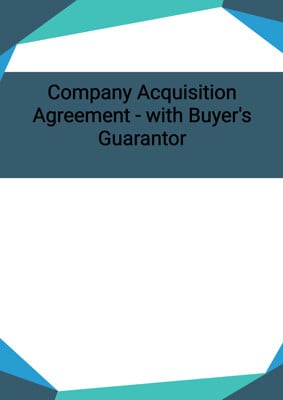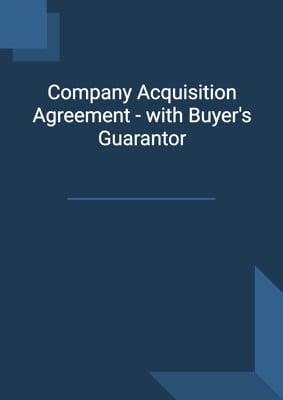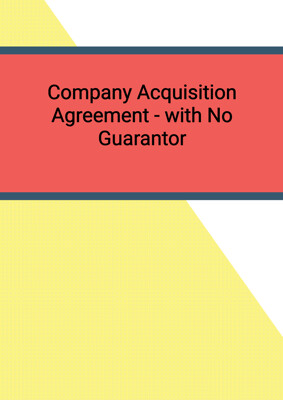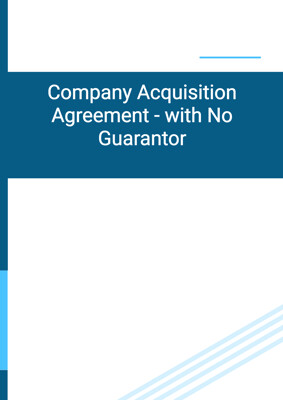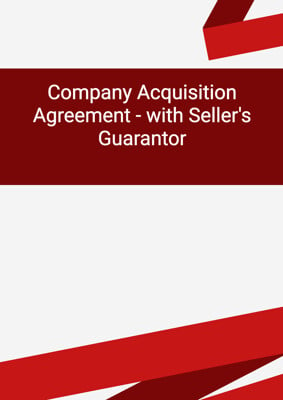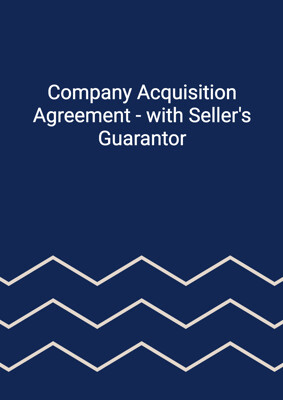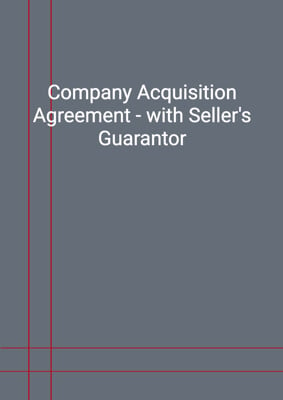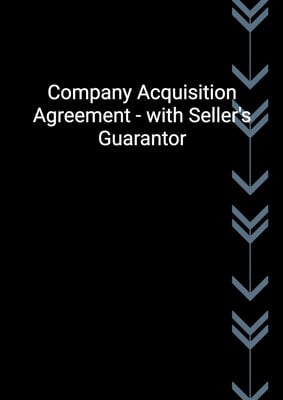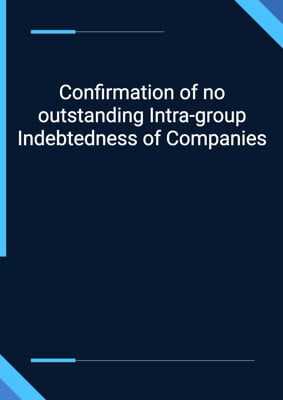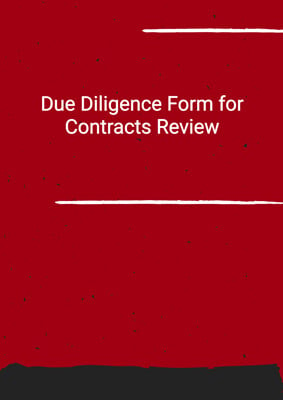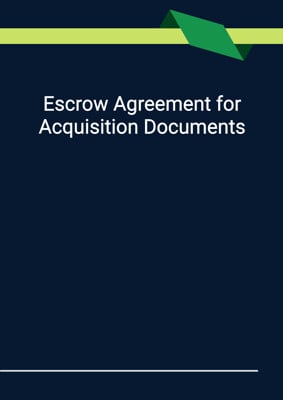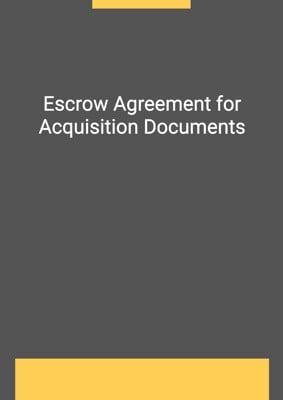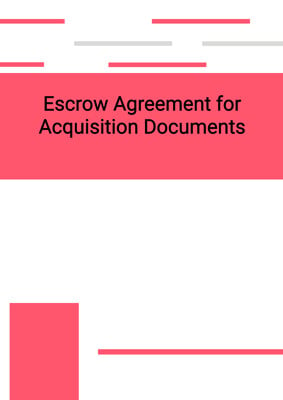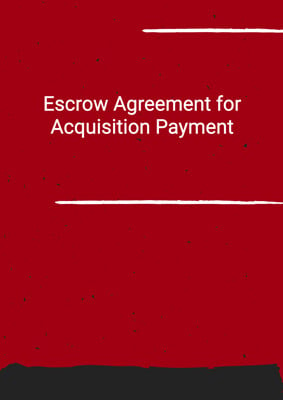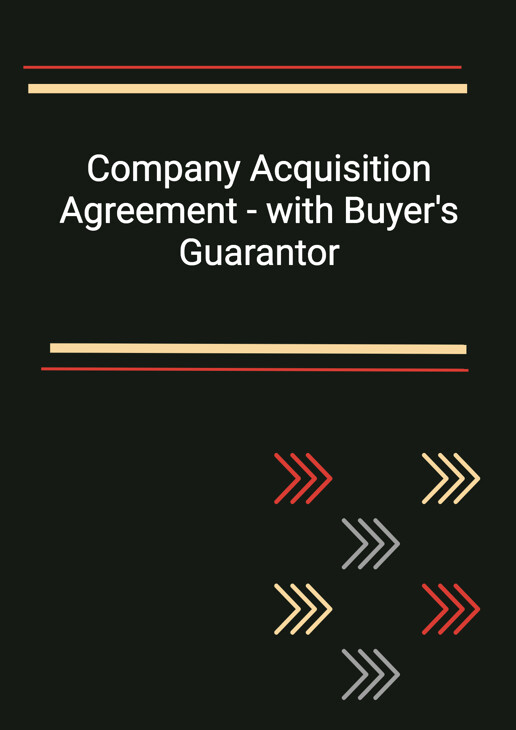
Company Acquisition Agreement - with Buyer's Guarantor
Seller Form - 2 Sellers
A company acquisition agreement between a Buyer and 2 Sellers with the Buyer's parent guaranteeing the obligations. The Sellers' warranties are included in another template. This agreement is drafted in favour of the Sellers.
How to Tailor the Document for Your Need?
01
Create Document
Fill in the details of the parties. You can click the "Fill with Member’s Information" button to complete it with information saved to your account.
02
Fill Information
Please fill in any additional information by following the step-by-step guide on the left hand side of the preview document and click the "Next" button.
03
Get Document
When you are done, click the "Get Document" button and you can download the document in Word or PDF format.
04
Review Document
Please get all parties to review the document carefully and make any final modifications to ensure that the details are correct before signing the document.
Document Preview
Document Description
The Company Acquisition Agreement - with Buyer's Guarantor is a legal document that outlines the terms and conditions for the acquisition of a company. It is entered into between the sellers, the guarantor, and the buyer. The agreement highlights the importance of the document by emphasizing the significance of the acquisition and the obligations of the parties involved.
The entire document is divided into several sections, each addressing specific aspects of the acquisition. The introduction provides a brief overview of the agreement, stating that the sellers are the sole legal and beneficial owners of the share capital of the company, and they have agreed to sell all of the issued share capital to the buyer. The guarantor has agreed to guarantee the performance of the buyer's obligations under the agreement.
Section 1 of the agreement deals with the interpretation of the terms used in the document. It defines various expressions and provides clarity on their meanings. Section 2 focuses on the sale of the shares and the price. It specifies the number of shares to be sold, the consideration for the shares, and the payment terms.
Section 3 outlines the conditions to be fulfilled for the completion of the sale and purchase of the shares. These conditions include the passing of a resolution by the shareholders of the buyer, obtaining written consents from relevant parties, and the repayment of outstanding intra-group indebtedness.
Section 4 covers the pre-completion undertakings, which include allowing the buyer's representatives access to the books and records of the company, conducting the business in the usual course, and taking steps to preserve and protect the business assets.
Section 5 details the completion process, including the delivery of share transfers, share certificates, and other relevant documents. It also addresses the payment of the purchase price and the notification of the fulfillment of conditions.
Section 6 deals with the preparation of completion accounts, which are prepared after completion to determine the net tangible assets and the final purchase price. It outlines the process for preparing the accounts, notifying the buyer of any non-acceptance, and resolving any disputes.
Section 7 covers the post-completion undertakings, including the repayment of connected trading indebtedness, the release of connected guarantees, and the cessation of using certain trade or service marks.
Section 8 and 9 contain the warranties provided by the buyer and the sellers, respectively. These warranties represent the representations and assurances made by each party regarding the accuracy and completeness of the information provided.
Section 10 establishes the limitations on claims, including the notice requirements, the maximum liability of the sellers, and the exclusions for certain breaches of warranty.
Section 11 grants the sellers the right to terminate the agreement in case of a breach by the buyer or any event that materially affects the business or financial position of the group.
Section 12 addresses withholding tax and grossing up, ensuring that the buyer pays the full amount due under the agreement, even if tax deductions or withholdings are required.
Section 13 emphasizes that this agreement and the disclosure letter set out the entire agreement between the parties, superseding any prior agreements or understandings.
Section 14 states that any variation of the agreement must be in writing and signed by all parties. It also clarifies that any variation does not constitute a waiver of any provisions of the agreement.
Section 15 allows for the assignment of rights under the agreement, subject to certain conditions and notifications.
Section 16 addresses the announcement and disclosure requirements, ensuring that no announcements or circulars are made without the prior written approval of the other party.
Section 17 deals with the costs incurred in connection with the agreement, stating that each party is responsible for its own costs, except for stamp duty and transfer taxes, which are borne by the buyer.
Section 18 emphasizes that if any provision of the agreement is held to be invalid or unenforceable, it shall be deemed not to be included, without affecting the remaining provisions.
Section 19 clarifies that time is of the essence in this agreement, emphasizing the importance of meeting the specified times, dates, and periods.
Section 20 requires the parties to perform all further acts and execute any further documents necessary to implement and give effect to the agreement.
Section 21 introduces the guarantor, who unconditionally and irrevocably guarantees the performance of the buyer's obligations under the agreement.
Section 22 addresses waivers, the buyer's rights and remedies, and the limitations on the sellers' liabilities under the agreement.
Section 23 clarifies that no third party has the right to enforce any terms of the agreement.
Section 24 specifies that the agreement is governed by the laws of the relevant jurisdiction and any disputes shall be subject to the jurisdiction of the relevant courts.
Section 25 outlines the requirements for notices and service, including the methods of delivery and the addresses of the parties.
Section 26 states that time is of the essence in this agreement, emphasizing the importance of meeting the specified times, dates, and periods.
The document provides a comprehensive and detailed framework for the acquisition of a company, ensuring that all parties understand their rights, obligations, and limitations.
How to use this document?
1. Review the entire document to understand the terms and conditions of the Company Acquisition Agreement - with Buyer's Guarantor.
2. Familiarize yourself with the introduction, which highlights the importance of the agreement and the obligations of the parties involved.
3. Read each section of the agreement carefully, paying attention to the specific details and requirements outlined.
4. Ensure that you understand the interpretation of terms used in the agreement, as defined in Schedule 1.
5. Take note of the sale of shares and the price, including the consideration and payment terms specified in Section 2.
6. Review the conditions to completion outlined in Section 3, ensuring that all necessary conditions are fulfilled.
7. Understand the pre-completion undertakings in Section 4, including access to books and records, conducting business in the usual course, and asset preservation.
8. Familiarize yourself with the completion process described in Section 5, including the delivery of share transfers, share certificates, and other relevant documents.
9. Pay attention to the preparation of completion accounts in Section 6, including the process for preparing the accounts, resolving any disputes, and determining the final purchase price.
10. Understand the post-completion undertakings in Section 7, such as the repayment of connected trading indebtedness and the cessation of using certain trade or service marks.
11. Review the warranties provided by the buyer and the sellers in Sections 8 and 9, respectively, ensuring that all representations and assurances are accurate and complete.
12. Understand the limitations on claims outlined in Section 10, including the notice requirements, maximum liability of the sellers, and exclusions for certain breaches of warranty.
13. Familiarize yourself with the termination rights of the sellers in Section 11, ensuring compliance with the specified conditions.
14. Pay attention to the withholding tax and grossing up provisions in Section 12, ensuring that all payments are made in full.
15. Understand that the agreement and the disclosure letter set out the entire agreement between the parties, as stated in Section 13.
16. Review the provisions regarding variation, assignment, announcements, costs, and severability in Sections 14-18.
17. Familiarize yourself with the guarantor's obligations and the buyer's rights and remedies in Sections 21 and 22.
18. Understand that no third party has the right to enforce any terms of the agreement, as stated in Section 23.
19. Review the governing law and jurisdiction provisions in Section 24, ensuring compliance with the relevant laws and courts.
20. Pay attention to the notice and service requirements outlined in Section 25, ensuring that all communications are delivered in the specified manner.
21. Understand that time is of the essence in this agreement, as emphasized in Section 26.
22. Seek legal advice if necessary to ensure full compliance with the terms and conditions of the Company Acquisition Agreement - with Buyer's Guarantor.
Not the right document?
Don’t worry, we have thousands of documents for you to choose from:

